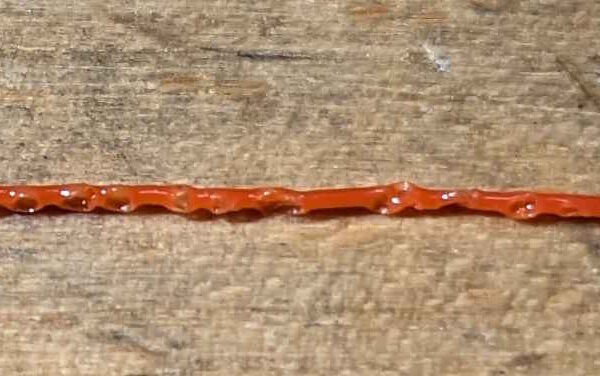Bubbles in filament
I have been using RepRapper PVB to make pretty large scale moulds (0.20 mm speed prints filling the entire print bed, each taking 20 hours) for a project for a few weeks now: it is cheap filament but I need cheap filament as I will require at least 10 kg of it for the job in hand. It has been printing fine up to now: temperature has to be quite low to flow nicely (200C) and there is quite a lot of stringing but it does a good enough job at this scale.
HOWEVER just now my MK4 has begun complaining of stuck filament and, when I reload the filament, there appear to be bubbles in the filament as it is purging:
It has printed again for a little while, then complained of stuck filament once more, I've done another reload and it is currently printing again.
Aside from "you've got some dodgy filament there mate" does anyone have any advice on how I might proceed? It is almost like the filament is being overheated, but the nozzle temperature remains at 200C and reducing it only seems to make the flow worse.
Best Answer by Diem:
Never assume that new filament is dry. It was packed dry but it may have been on a wholesaler's shelf for months, treated badly in transit and perhaps not perfectly sealed in the first place - then at this time of year some filaments absorb moisture in just a few hours. A 20 hour print is plenty of time to absorb enough water that while the first layers are good the last ones are affected.
Cheerio,
As the season changes central heating and aircon are paused and humidity rises for a while we see a lot of this.
PVB is another hygroscopic filament 'though less well known than some.
The bubbles are caused by steam explosions as the filament melts and the water boils - listen carefully and you may hear fizzing and popping from the extruder.
The moisture will also cause stringing and mess with internal extrusion pressures so:
Dry your filament.
Cheerio,
RE:
Thanks for the advice: the filament arrived (from Amazon) yesterday, and only came out of the bag it was sealed in (and it was sealed) with its little dehydrating baggie minutes before I started the print, probably about 15 hours ago now (it was a 20 hour print). So it _should_ be as dry it as it was ever going to be.
I'll say it: "you've got some dodgy filament there mate" :-).
I'll switch the oven on...
Never assume that new filament is dry. It was packed dry but it may have been on a wholesaler's shelf for months, treated badly in transit and perhaps not perfectly sealed in the first place - then at this time of year some filaments absorb moisture in just a few hours. A 20 hour print is plenty of time to absorb enough water that while the first layers are good the last ones are affected.
Cheerio,
RE: Bubbles in filament
Update: I've had the filament in an oven at 50 C for 24 hours now and it has helped maybe a little (no sputtering noise now) but not enough to make a difference. There are bubbles every centimetre or so still while the filament is purging and the printer detects a jam after a few hours, which is sometimes recoverable the first time but usually not the second time.
Is any other approach advisable or is this filament beyond recovery?
That's a long time for little gain - I presume you have a recirculating fan oven..? If so you need to leave the door open a crack for newly saturated air to escape ... which is why a lot of us use food dehydrators.
I wouldn't discard the filament just yet, it may still benefit from extended drying, stick it in alongside whatever else you're drying for a few weeks and keep it in a zipock bag with dessicant in between.
But I would try another filament in the the interim.
Cheerio,
RE: Bubbles in filament
Hmm, yes, leaving the door open a crack is a bit difficult with my oven, and in fact having the oven occupied with this for a long period is annoying and probably costly, I'll go look for a food dehydrator.
What I'm trying right now is switching the "stuck filament" detector off, see if the print manages to complete anyway. I will persevere: if I can get prints out of this filament that are sufficiently good then at 1/4 the price it is worth the effort.
RE: Bubbles in filament
FYI switching the "stuck filament" detector off did allow a 20 hour print to complete with sufficient quality for my use case, so I think I'm working again.
RE: Bubbles in filament
One more update on this: I did have another filament blockage even after disabling the "stuck filament" detector so I asked RepRapper for advice. They responded very swiftly that PVB is pretty hygroscopic and so I should (a) fit a dehydrator (I now run the filament from a eSun eBox Lite) and (b) use a rather lower nozzle temperature: I have gone with 195 first layer, 190 thereafter. I've not had a blockage since and the quality remains sufficient for my purposes.
